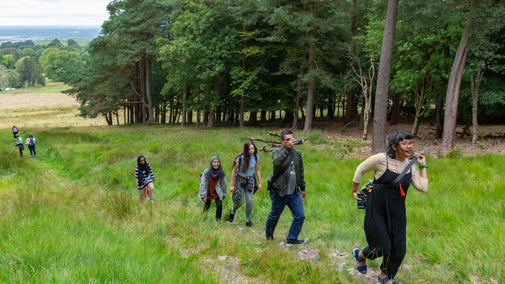Hod Hill butterfly walk
Dorset
This mile-long trail involves a gentle stroll around the Iron Age fort at Hod Hill, with a special focus on spotting the many species of butterfly that live here. Marbled whites, blues, small heath and clouded yellows can all be found flitting about the wildflowers that grow here in abundance. Look out also for the remnants of the old Roman fort, built within the ramparts of the much older hillfort and one of the best preserved sites of this kind in the UK.
Near to
Hod HillStart point
Car park on Hanford Lane, grid ref: ST855112Trail information
*A mostly level walk with one steep climb at the beginning. For further details, please see Terrain section.
**Uneven ground may be unsuitable for visitors with disabilities. For further details, please see section marked Access.
***Dogs welcome. For further details, please see section marked Facilities.
More near here
Hod Hill circular walk
This short walk skirts the ramparts of the Iron Age fort at Hod Hill. Perched high above a meander on the River Stour, if offers sweeping views over the Dorset countryside.

Walk at Badbury Rings and The Oaks
Enjoy impressive views across the Dorset countryside on this circular walk, while discovering the history, flora and fauna of the Iron Age hillfort of Badbury Rings.

Get in touch
Our partners

We’ve partnered with Cotswold Outdoor to help everyone make the most of their time outdoors in the places we care for.
You might also be interested in
Walking
Explore some of the finest landscapes in our care on coastal paths, accessible trails, woodland walks and everything in between. Find the best places to walk near you.

Boosting Hod Hill's archaeology and wildlife
Find out how a generous £800k award made to the National Trust by Postcode Earth Trust has benefited Hod Hill, as well as other hillforts around Dorset and Wiltshire.
Walking in Dorset
From strolls along the coastline by the sea to spectacular views over three counties at the top of Hambledon Hill, these are some of the best walks in Dorset this winter season.

Staying safe at National Trust places
The special places in National Trust care sometimes come with a few risks for visitors, be it coastline or countryside. Find out how to keep safe throughout your visits.

Follow the Countryside Code
Help to look after National Trust places by observing a few simple guidelines during your visit and following the Countryside Code.

Cotswold Outdoor: our exclusive walking partner
Learn about the National Trust’s ongoing partnership with Cotswold Outdoor. Find out how they help us care for precious places and the exclusive discount available for National Trust supporters.

